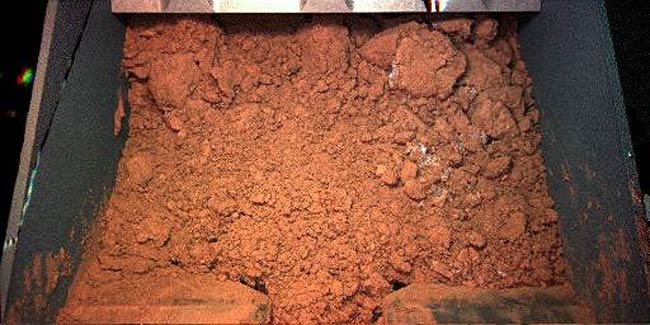Phoenix Sampling of Martian Soil Delayed

NASA scientists delayed the Phoenix Mars Lander's sample gathering for one sol, or Martian day, they announced on Tuesday, in order to practice moving the craft's robotic arm and to deal with a slight glitch with one of the lander's instruments.
The mission team performed an initial "dig and dump" with the lander's robotic arm scoop on Sunday, which Phoenix principal investigator Peter Smith described as "sort of what a child does on the beach with their sand pail and shovel."
However, the mission scientists are doing their digging "blind" ? from millions of miles away, sending instructions to the lander in the morning and getting data back on maneuvers in the evening. "It's like explaining to someone over the telephone how to tie their shoes," Smith noted.
The $420 million dollar mission is designed to dig down into the soil of the Martian arctic to the layers of water ice thought to lie underneath to see if that ice might once have been liquid and could have created a habitable zone for microbial life at some point in the past.
After programming that first dig and dump, scientists had trouble finding the pile of discarded Martian soil. "Yesterday we had a bit of a mystery," Smith, of the University of Arizona, said.
They were eventually able to find the small pile in an image taken the same day as the dump, but scientists then decided they needed to practice with the arm more and do another "dig and dump."
"They haven't really mastered it," Smith said. "Doing this slowly and deliberately is the right thing to do."
Get the Space.com Newsletter
Breaking space news, the latest updates on rocket launches, skywatching events and more!
The second "dig and dump" command was sent to the lander on Monday night and should occur during the day on Tuesday.
Some of the soil from the first "dig and dump" also unexpectedly stuck to the scoop; Smith is unsure why this would happen but says the scientists must now be more careful so they don't inadvertently dump soil onto the lander.
Mission controllers hit another snag when images returned from Phoenix showed that one of the doors to its Thermal and Evolved-Gas Analyzer (TEGA) had only partially opened (the other opened completely).
"This is not what we expected," Smith said. But he added that they believe the problem is temperature-related and that once the temperatures warm up in the afternoon on Mars, the door will completely open. If it doesn't, "we know that we can get a sample into our oven exactly the way we want to even with a door partially open," he said.
Still, the team decided that this is another good reason to delay sample gathering by one day.
"I think one more day and we're there," Smith said.
Join our Space Forums to keep talking space on the latest missions, night sky and more! And if you have a news tip, correction or comment, let us know at: community@space.com.

Andrea Thompson is an associate editor at Scientific American, where she covers sustainability, energy and the environment. Prior to that, she was a senior writer covering climate science at Climate Central and a reporter and editor at Live Science, where she primarily covered Earth science and the environment. She holds a graduate degree in science health and environmental reporting from New York University, as well as a bachelor of science and and masters of science in atmospheric chemistry from the Georgia Institute of Technology.









